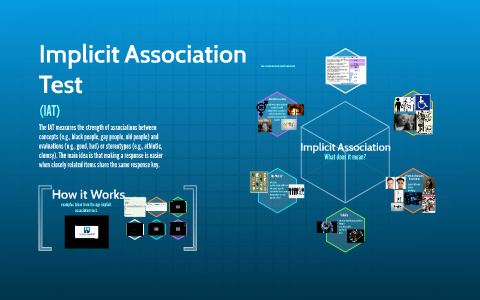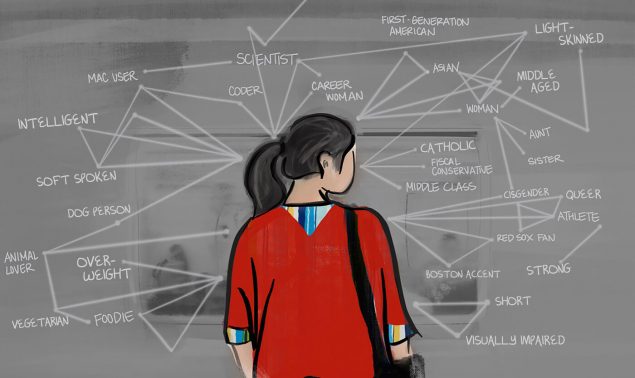IAT: Unveiling the Implicit Affiliation Take a look at and its Controversies
Associated Articles: IAT: Unveiling the Implicit Affiliation Take a look at and its Controversies
Introduction
With enthusiasm, let’s navigate via the intriguing subject associated to IAT: Unveiling the Implicit Affiliation Take a look at and its Controversies. Let’s weave fascinating data and supply contemporary views to the readers.
Desk of Content material
IAT: Unveiling the Implicit Affiliation Take a look at and its Controversies

The Implicit Affiliation Take a look at (IAT) has develop into a outstanding instrument in social psychology, aiming to measure implicit attitudes and biases that people could also be unaware of or unwilling to report. Developed by Anthony Greenwald, Debbie McGhee, and Jordan Schwartz, the IAT presents members with a collection of phrases and pictures, requiring them to categorize them as shortly as potential. The pace and accuracy of those categorizations are then used to deduce the energy of implicit associations between ideas. Whereas lauded for its modern method to understanding unconscious biases, the IAT has additionally confronted vital criticism relating to its validity, reliability, and sensible functions. This text will delve into the mechanics of the IAT, discover its functions and limitations, and look at the continuing debates surrounding its use.
The Mechanics of the IAT:
The IAT sometimes includes categorizing stimuli into 4 classes utilizing two response keys (e.g., left and proper). These classes are often associated in a manner that displays the implicit affiliation being examined. For instance, in a race IAT, members is likely to be requested to categorize faces (Black or White) and phrases (good or unhealthy). The important manipulation includes pairing one class of faces (e.g., Black faces) with one class of phrases (e.g., good phrases) in a single block of trials, after which switching the pairings in one other block (e.g., Black faces with unhealthy phrases). The distinction in response occasions between these two blocks is the important thing measure. Quicker responses when suitable classes are paired (e.g., Black faces with good phrases) counsel a stronger implicit affiliation between these classes.
The IAT employs a complicated statistical evaluation to account for particular person variations in response time and total pace. The ensuing "IAT rating" represents the relative energy of the implicit affiliation, sometimes starting from a powerful constructive affiliation (indicating a choice for one class over one other) to a powerful damaging affiliation (indicating a choice for the alternative class). A rating close to zero signifies no vital implicit choice.
Functions of the IAT:
The IAT’s versatility has led to its software in varied fields, together with:
-
Understanding prejudice and discrimination: The IAT has been broadly used to discover implicit biases associated to race, gender, age, sexual orientation, weight, and different social teams. Research have proven that even people who consciously endorse egalitarian views could exhibit implicit biases on the IAT. This has vital implications for understanding how unconscious biases can contribute to discriminatory habits, even with out aware intent.
-
Predicting habits: Analysis means that IAT scores can predict sure behaviors, though the predictive energy is commonly modest and context-dependent. For instance, some research have proven a correlation between IAT scores and discriminatory habits in hiring selections or interracial interactions.
-
Evaluating the effectiveness of interventions: The IAT can be utilized to evaluate the influence of interventions designed to scale back implicit biases. By measuring IAT scores earlier than and after an intervention, researchers can consider its effectiveness in altering implicit attitudes.
-
Self-awareness and private development: Whereas the IAT is primarily a analysis instrument, some people use it as a instrument for self-reflection and private development. By understanding their implicit biases, people could also be higher outfitted to deal with their very own prejudices and promote extra equitable interactions.
Criticisms and Limitations of the IAT:
Regardless of its widespread use, the IAT has confronted substantial criticism:
-
Validity: A serious concern is the validity of the IAT as a measure of implicit attitudes. Critics argue that the IAT doesn’t immediately measure attitudes however quite displays a wide range of cognitive processes, together with familiarity, response methods, and cultural information. The interpretation of IAT scores as reflecting real implicit biases is due to this fact questioned. Some research have even proven that IAT scores may be influenced by elements unrelated to attitudes, such because the order of stimulus presentation.
-
Reliability: The reliability of the IAT has additionally been debated. Whereas test-retest reliability is usually average, it varies throughout completely different populations and contexts. The susceptibility of IAT scores to situational elements and particular person variations in cognitive skills raises considerations concerning the consistency of the measure.
-
Predictive validity: Though some research have discovered correlations between IAT scores and habits, the predictive validity of the IAT is commonly weak. The IAT’s capacity to foretell real-world habits is proscribed, and plenty of elements apart from implicit attitudes affect habits.
-
Moral concerns: The usage of the IAT raises moral considerations, notably relating to the potential for stigmatization and self-blame. Contributors could expertise misery or anxiousness upon studying about their implicit biases, particularly if they’re unaware of those biases or strongly disagree with them.
-
Interpretation and software: The interpretation and software of IAT scores require warning. It is essential to keep away from oversimplifying the outcomes and attributing advanced social phenomena solely to implicit biases. Contextual elements and different variables should be thought-about when decoding IAT scores and drawing conclusions about particular person attitudes and behaviors.
Ongoing Debates and Future Instructions:
The controversy surrounding the IAT’s validity and utility continues. Researchers are actively working to enhance the IAT’s methodology, refine its interpretation, and develop different measures of implicit attitudes. Some researchers are exploring using course of dissociation procedures to disentangle completely different cognitive processes contributing to IAT scores. Others are creating new implicit measures that deal with a number of the limitations of the IAT.
Regardless of the criticisms, the IAT has contributed considerably to our understanding of implicit biases and their potential influence on social interactions. It has raised consciousness of the pervasiveness of unconscious biases and highlighted the necessity for interventions to advertise extra equitable and inclusive societies. Nevertheless, it is essential to acknowledge the constraints of the IAT and to make use of it responsibly, avoiding overinterpretation and misapplication of its outcomes. Future analysis ought to give attention to bettering the IAT’s psychometric properties, clarifying its theoretical underpinnings, and creating extra strong measures of implicit attitudes and their affect on habits. By fastidiously contemplating each the strengths and weaknesses of the IAT, researchers can proceed to leverage its potential whereas mitigating its limitations, contributing to a extra nuanced understanding of implicit bias and its societal implications. The continued dialogue surrounding the IAT underscores the complexity of measuring unconscious processes and the necessity for a cautious and significant method to decoding and making use of its findings. In the end, the IAT serves as a useful instrument for analysis, however its limitations should be fastidiously thought-about to keep away from misinterpretations and guarantee moral software.








Closure
Thus, we hope this text has offered useful insights into IAT: Unveiling the Implicit Affiliation Take a look at and its Controversies. We thanks for taking the time to learn this text. See you in our subsequent article!